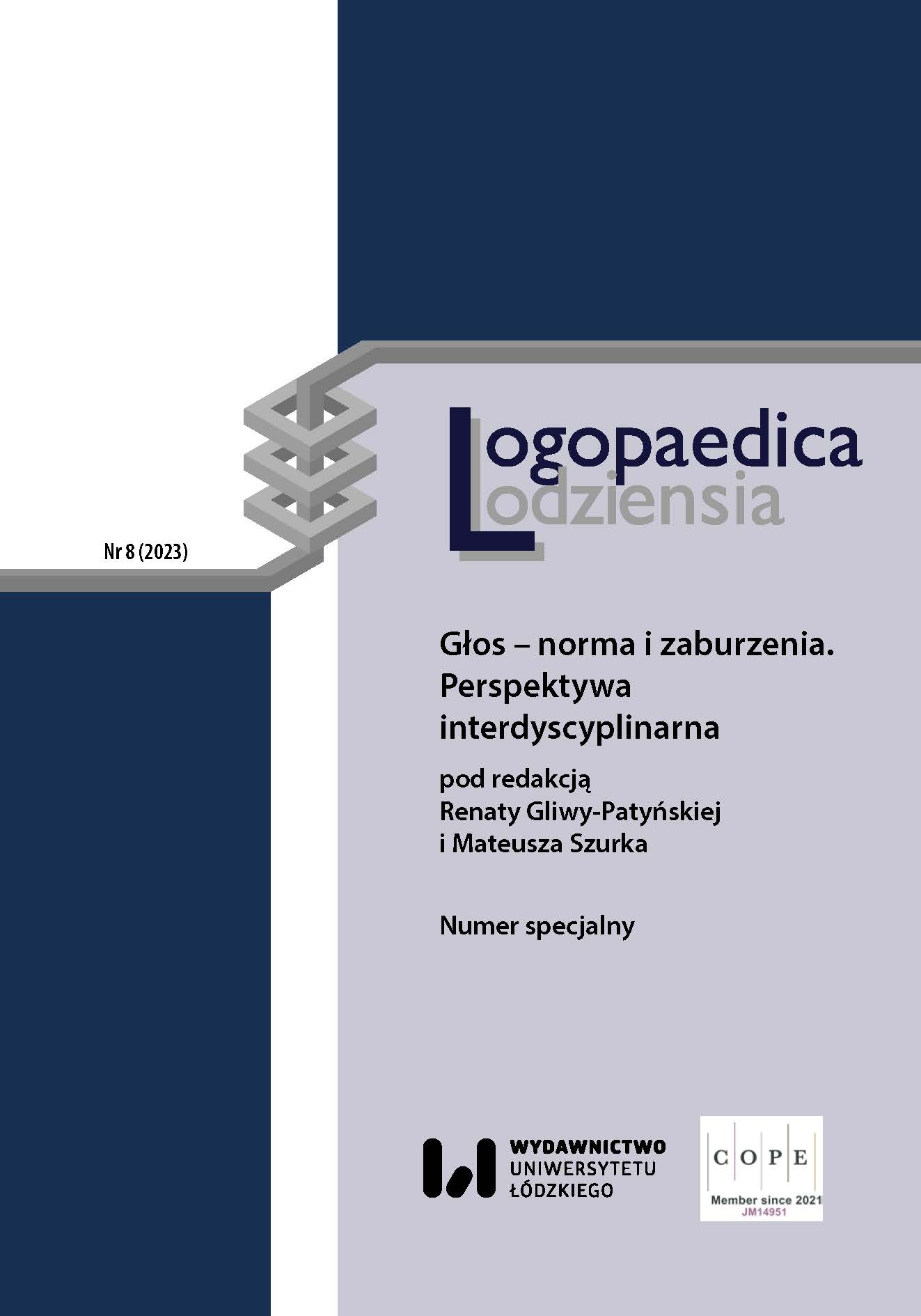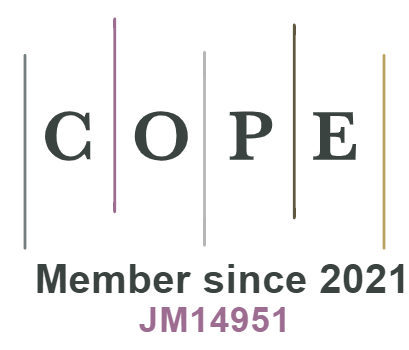The Voice Rehabilitation in Patients After Total Laryngectomy. What Has Changed?
DOI:
https://doi.org/10.18778/2544-7238.08.09Keywords:
voice rehabilitation, total laryngectomyAbstract
The most unpleasant consequence of laryngectomy is the inability to communicate with a sonorous voice. One way to overcome these depressing feelings is to focus on the most important problem at the moment: learning replacement speech. The mechanism of creating the esophageal voice is as follows: the role of the vibration generator is taken over by the upper part of the esophagus, the so‑called mouth of the esophagus, forming a pseudoglossus, and the esophagus is the reservoir of air. The air expelled from the esophagus with an antiperistaltic movement vibrates the pseudo‑loudspeaker, creating a basic sound, which is then appropriately modulated in slightly altered resonance and articulation cavities. It is advisable to start the introductory exercises for learning voice and substitute speech before the surgery. The actual rehabilitation begins after the wound has healed, preferably during hospitalisation. The first exercises should be conducted by a doctor to prevent developing abnormal habits that make it difficult to master the substitute speech. The quality of esophageal speech and the speed of mastering it depends not only on the persistence and regularity of the practitioner. The effectiveness of rehabilitation is delayed by high tension of the esophageal mouth sphincter, the extent of surgery, radiotherapy, hearing loss, poor dental condition, and coexisting diseases. Voice prosthesis implantation is one of the two currently considered equivalent methods of voice rehabilitation in patients after complete removal of the larynx due to cancer. It is a method of surgical voice rehabilitation. The pioneer of this method in Poland was a well‑known and recognised otolaryngologist, prof. Erwin Mozolewski, who first applied voice rehabilitation using a voice prosthesis in Szczecin in 1972. The method of surgical rehabilitation of speech in patients after laryngectomy consists in creating a tracheo‑esophageal fistula and implanting a simple, unidirectional air valve, the so‑called voice prosthesis. This allows the patient, when closing the tracheostomy with a finger, to direct the exhaled air from the lungs to the esophagus and the lower pharynx to produce a substitute basic tone in the same place as in the case of esophageal speech (in the so‑called pharyngeal segment).
Downloads
References
Bień S., Okła S., 2006, Historia rehabilitacji głosu i mowy u chorych po usunięciu krtani, „Otorynolaryngologia”, t. 5, s. 17–23.
Google Scholar
Cruz S., Viana R., Guimarães J., Fernandes J., Castro Silva J., Monteiro E., 2014, Tracheoesophageal Voice Prosthesis Outcomes: Success or Insucess?, „International Journal of Otorhinolaryngology and Head and Neck Surgery”, Vol. 140(3), s. 14–22.
Google Scholar
DOI: https://doi.org/10.4236/ijohns.2014.31004
Hamerlińska A., 2019, Popularyzacja protez głosowych a lęk przed ich zastosowaniem u osób po laryngektomii całkowitej, „Niepełnosprawność – Dyskursy Pedagogiki Specjalnej”, nr 34, s. 38–51, https://doi.org/10.4467/25439561.NP.19.016.11846
Google Scholar
DOI: https://doi.org/10.4467/25439561.NP.19.016.11846
Hotz M.A., Baumann A., Schaller I., Zbären P., 2002, Success and predictability of provox prosthesis voice rehabilitation, „Archives of Otorhinolaryngology – Head and Neck Surgery”, Vol. 128(6), s. 687–691.
Google Scholar
DOI: https://doi.org/10.1001/archotol.128.6.687
Kazi R., De Cordova J., Singh A., Venkitaraman R., Nutting C.M., Clarke P., Rys‑Ewans P., Harrington K.J., 2007, Voice‑related Quality of Life in Laryngectomees: Assessment Using the VHI and V‑RQOL Symptom Scales „Journal of Voice”, Vol. 21(6), s. 728–734.
Google Scholar
DOI: https://doi.org/10.1016/j.jvoice.2006.05.008
Kosztyła‑Hojna B., Rogowski M., Łuczaj J., Kasperuk J., 2008, Jakość głosu i mowy u chorych po całkowitym usunięciu krtani, rehabilitowanych chirurgicznie z zastosowaniem protez głosowych drugiej generacji, „Polski Merkuriusz Lekarski”, t. 25, nr 147, s. 230–235.
Google Scholar
Latkowski J.B., Olszewski J., Kosiek K., 2010, Podstawy farmakoterapii i fizjoterapii w wybranych jednostkach otorynolaryngologii, Łódź: GEERS Akustyka Słuchu Sp. z o.o.
Google Scholar
Lipiec D., 2009, Zrozumiałość mowy przełykowej – doniesienia z badań własnych, „Logopeda”, t. 1, nr 7, s. 32–46.
Google Scholar
Lundström E., Hammarberg B., Munck‑Wikland E., 2009, Voice Handicap and Health‑Related Quality of Life in Laryngectomees: Assessments with the Use of VHI and EORTC Questionnaires, „ Folia Phoniatrica et Logopaedica”, Vol. 61(2), s. 83–92.
Google Scholar
DOI: https://doi.org/10.1159/000208807
Markowski J., Piotrowska‑Seweryn A., Witkowska M., Wardas P., Paluch J., Pilch J., Likus W., 2014, Ocena skuteczności rehabilitacji głosu po zabiegu implantacji protez głosowych typu Provox 2 u pacjentów laryngektomowanych, „Otorynolaryngologia”, t. 13, nr 3, s. 163–168.
Google Scholar
Mozolewski E., 1972, Chirurgiczna rehabilitacja głosu i mowy po laryngektomii, „Otolaryngologia Polska”, t. 26, nr 6, s. 653–661.
Google Scholar
Niebudek‑Bogusz E., Kuzańska A., Woźnicka E., Kopczyński J., Śliwińska‑Kowalska M., 2008, Samoocena głosu za pomocą wskaźnika niepełnosprawności głosowej VHI u pacjentów z porażeniem fałdów głosowych, „Otorynolaryngologia”, t. 7, nr 4, s. 196–201.
Google Scholar
Okła S., 2012, Chirurgiczna rehabilitacja głosu po całkowitej laryngektomii, Warszawa: Wydawnictwo Lekarskie PZWL.
Google Scholar
Pruszewicz A., 1992, Foniatria kliniczna, Warszawa: Państwowy Zakład Wydawnictw Lekarskich.
Google Scholar
Pruszewicz A., Obrębowski A., Donat‑Jasiak T., 1983, Kompleksowa rehabilitacja chorych po laryngektomii, „Otolaryngologia Polska”, t. 37, s. 159–160.
Google Scholar
Sinkiewicz A., 2009, Pacjent po operacji krtani, Bydgoszcz: Bydgoskie Stowarzyszenie Laryngektomowanych.
Google Scholar
Staffieri M., 1981, Laryngoplasty after total laryngectomy, „Archives of Otolaryngology”, Vol. 40, s. 254–262.
Google Scholar
Zimmer‑Nowicka J., Morawiec‑Bajda A., 2007, Rehabilitacja głosu i jakość życia chorych po laryngektomii całkowitej z wszczepionymi protezami głosowymi typu Provox, „Otolaryngologia Polska”, t. 6, nr 1, s. 39–44.
Google Scholar
Zimmer‑Nowicka J., Morawiec‑Sztandera A., 2012, Przyczyny i czas pomiędzy kolejnymi wymianami protez głosowych u chorych po laryngektomii – analiza 184 wymian u 42 chorych, „Otolaryngologia Polska”, t. 65, nr 5, s. 322–327.
Google Scholar
DOI: https://doi.org/10.1016/j.otpol.2012.06.023
Downloads
Published
How to Cite
Issue
Section
License

This work is licensed under a Creative Commons Attribution-NonCommercial-NoDerivatives 4.0 International License.











